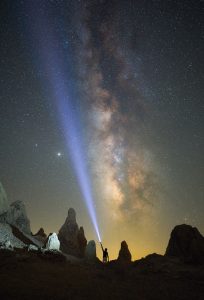Key Takeaways:
- Before electricity was discovered, humans were using fire and fuel sources to have prolonged light
- Battery-operated lights were invented in the 19th century, but their size was too big for everyday use
- Advancements in technology and materials have helped the flashlights grow into what they are today
In today's world, we often take the convenience of a flashlight for granted, easily turning it on to illuminate our path during dark hours. However, the history of flashlights is an intriguing tale of ingenuity, innovation, and perseverance. From humble beginnings to the modern marvels we have today, the evolution of flashlights has been marked by technological advancements and significant cultural impacts. Join us on this illuminating journey as we delve into the fascinating history of flashlights.
Early Origins: The Ancient Beacons
Long before the invention of electricity, humans sought ways to conquer the darkness. Historical records show that ancient civilizations used various methods to create light sources. Early lamps, made of clay, stone, or metal, were filled with animal fats, oils, or plant-based materials, providing a crude form of illumination. The Greeks, for example, used ceramic lamps with a wick soaked in oil to create their own form of portable lighting. The invention of candles helped people light their way, but most early-day candles could be burned up within only an hour.
The First Battery-Powered Light: The Arc Lamp
The true transformation of flashlights began in the early 19th century with the discovery of electricity. The groundwork for battery-powered portable lights was laid by Sir Humphry Davy in 1802 when he invented the first electric arc lamp. These arc lamps operated with two carbon rods that would be placed close to one another in holders made of non-conductive material. A battery would then send a high voltage to said rods; because of the space in between the carbon rods, a discharge of electricity would be created which would be an intense bright light. However, these early arc lamps were impractical for everyday use due to their large size and high power consumption which only allowed them to be used for outside public lighting.
The Breakthrough: The Incandescent Flashlight
The pivotal moment in flashlight history arrived in 1899 when the British inventor David Misell patented the first practical flashlight. He used a carbon-filament bulb, powered by three D zinc batteries, encased in a cylindrical metal tube. They were called flashlights because the batteries couldn’t hold a steady current for long periods which caused the flashlight to flash at times. This invention marked the transition from the era of oil lamps to the age of electric flashlights.
In 1902, the first commercial flashlight hit the market courtesy of Conrad Hubert and the Ever-Ready Company, which later became Eveready (and is still around today), and began mass-producing flashlights for public consumption. These early flashlights were basic by today's standards, with simple on-off switches and limited battery life. However, they proved invaluable in various fields, including mining, military, and public safety.
As time went on engineers created flashlights with sturdier designs, water-resistant cases, and more efficient bulbs. These developments accelerated the flashlight's popularity in civilian life as well, as people recognized its multifaceted utility.

Leaping into Modern Technology: LED Flashlights
The 1960s marked a significant turning point in flashlight history with the development of light-emitting diodes (LEDs). Initially, LEDs were expensive and inefficient, but rapid progress in semiconductor technology made them a viable alternative to incandescent bulbs. By the late 1990s, LED flashlights began to dominate the market due to their enhanced durability, longer battery life, and lower energy consumption.
In recent years, flashlights have continued to evolve with cutting-edge innovations. The incorporation of rechargeable batteries, adjustable focus, tactical features, and miniaturization have revolutionized flashlight technology. Furthermore, advancements in materials and manufacturing have led to robust and lightweight designs suitable for extreme outdoor activities and emergencies.
If you’re looking for a flashlight for yourself, be sure to check out our best sellers here!
Going Beyond: LEP Flashlights
One of the most prominent new technologies today is LEP flashlights. An LEP (Laser Excited Phosphor) flashlight emits a blue laser beam that excites a material called phosphor. This phosphor absorbs the laser energy and subsequently emits visible light. The flashlight then utilizes lenses or reflectors to focus this light, resulting in the distinctive bright white and long-reaching LEP beam. Want to know more about LEP flashlights? Check out our blog about it here.
Recap:
From ancient clay lamps to the sophisticated LED flashlights of today, the history of these portable illuminators is a testament to human inventiveness and adaptability. The flashlight's evolution, driven by the necessity to conquer darkness and explore the unknown, showcases the remarkable progress of human civilization. As we move forward, it's exciting to imagine the future of flashlights and how they will continue to light our path in the years to come. Looking for more flashlight facts and history? Make sure to check out some of our other blogs like 10 Interesting Things You Didn’t Know About Flashlights!

2 thoughts on “Illuminating the Past: A Journey through the History of Flashlights”
-
Pingback: Illuminating History: A Look Into The Evolution Of Headlamps |
-
Pingback: The Evolution Of LEDs: From Invention To Innovation |
Leave a Reply